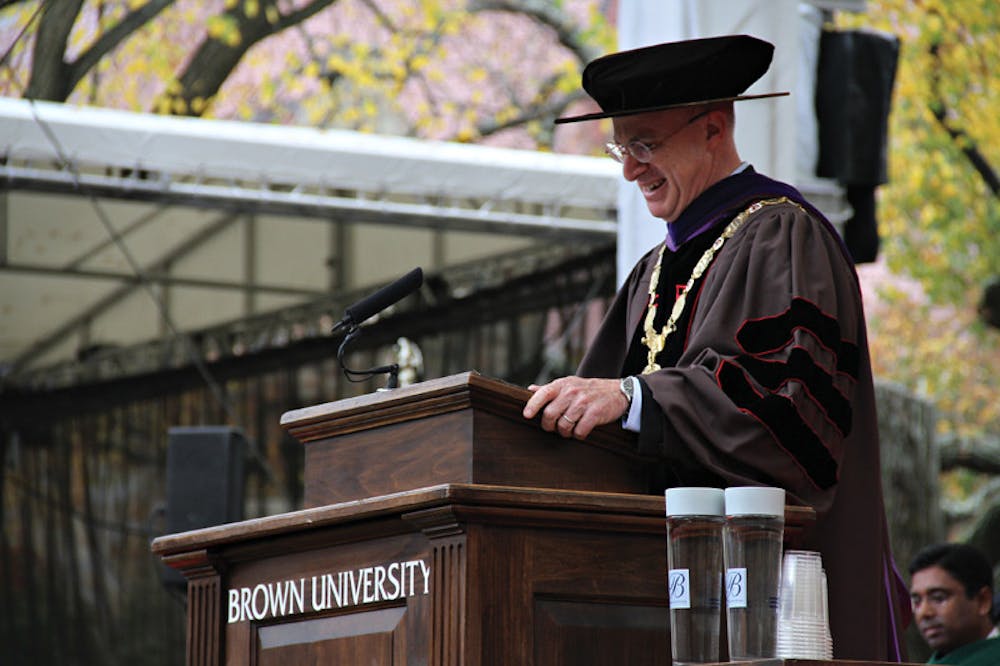The Corporation approved a 4 percent hike in undergraduate tuition and fees — the largest increase in three years — and an accompanying 5.6 percent increase in financial aid, President Christina Paxson announced in a campus-wide email Thursday morning.
The operating budget for fiscal year 2014 includes an expected $902 million in expenditures but only $897.6 million in revenue, running a $4.4 million deficit the University will cover by drawing from its reserves. The deficit is less than half the size of that of last year, when the Corporation voted to withdraw $9 million from its reserves.
The expanded operating budget, which was approved based on recommendations from the annual University Resources Committee report, is likely the largest in University history, said Beppie Huidekoper, executive vice president for finance and administration. But its 3.5 percent increase over last year’s budget actually constitutes one of the smaller rises in recent years, she added.
The Corporation, the University’s highest governing body, also gave the final stamp of approval for the proposed School of Public Health, which faculty members unanimously voted to approve in November, The Herald previously reported. Beginning in July, the school will undergo a two-year accreditation process before a targeted opening date of 2015.
The Corporation’s meetings last weekend were truncated by Winter Storm Nemo, which blanketed much of New England with about two feet of snow. The Corporation cut short its Friday meetings and postponed the main Saturday morning meeting, when the group typically takes action on its central priorities. Roughly 60 percent of Corporation members made it to the meetings that were held, said Provost Mark Schlissel P’15.
To make up for the lost time, the Corporation held a conference call Wednesday to cast votes on the budget, the public health school and other proposed changes, Schlissel said.
A series of discussions between Corporation members and strategic planning committee members was also cut short. Schlissel said the administration will set up video conference discussions throughout the semester instead, adding that he and Paxson intend to travel to New York, California and other major hubs to hold smaller, local meetings with groups of Corporation members.
Schlissel presented to Corporation members about the 82 Signature Academic Initiative proposals submitted by faculty members last semester, which the administration is currently evaluating, he said.
The increase in the University’s operation budget reflects higher expenditures on graduate student stipends, staff and faculty salaries, the School of Engineering, campus safety efforts and information technology, as well as a slightly larger number of faculty positions, according to Paxson’s email.
The tuition increase was “one of the toughest decisions” the URC had to make, Huidekoper said, adding that the total of Brown’s tuition and fees is lower than those of most other Ivies. Poor endowment returns in recent years provided part of the need to raise tuition, she said. As federal funding streams for research dry up over the next few years, the University will continue to seek new sources of revenue, Huidekoper said.
Once the University decided to raise tuition by 4 percent to fund important spending priorities, the Office of Financial Aid calculated the contingent increase in financial aid that would be necessary to continue meeting 100 percent of demonstrated need, Schlissel said. This year, the financial aid increase outstripped the rise in tuition, though last year the reverse was true, with tuition increasing 3.5 percent and financial aid 2.1 percent, The Herald reported at the time.
“We begin every budget discussion attempting to balance the things that are most important for continuing to make Brown a better university and the Brown education a more valuable education … against the cost,” he said, adding that “these are difficult trade-offs.”
Over the past decade, financial aid at Brown has risen by an average of 9.4 percent annually, while tuition and fees have risen by an average of 4.3 percent, Huidekoper said.
The Corporation approved plans to move forward with a renovation of the John Hay Library. The renovation, which could start this summer and is expected to last about a year, will open up the main reading room to become a larger study space for students and expand space for exhibits and special collections reading, said University Librarian Harriette Hemmasi, who is overseeing the effort.
The renovation will also entail improvements to the John Hay’s security system and installing a sprinkler system, Hemmasi said.
The Corporation approved more than $31 million in gifts to the University. The largest is a $10 million donation from Marty Granoff P’93, who provided the money for the administration to use at its discretion. Schlissel described the gift as an act of “amazing generosity,” adding that he and Paxson would meet with Granoff to determine the best use of the funds, potentially for priorities that emerge from strategic planning.
Other gifts include $5.5 million to be divided between the Rooftop Greenhouse and Conservatory of the Building for Environmental Research and Teaching and the Brown Annual Fund, $3 million for the John Hay renovation, $2 million for an endowed assistant professorship in brain science and $2 million for scholarships and endowments for Chinese students, Paxson wrote in the email.
The Corporation also elected Chancellor Thomas Tisch ’76 and Vice Chancellor Jerome Vascellaro ’74 P’07 to their third and final three-year terms, which will end in 2016. The weekend “provided an opportunity for substantive presentations, discussion and deliberation of critical issues for the University,” Tisch said.

ADVERTISEMENT




